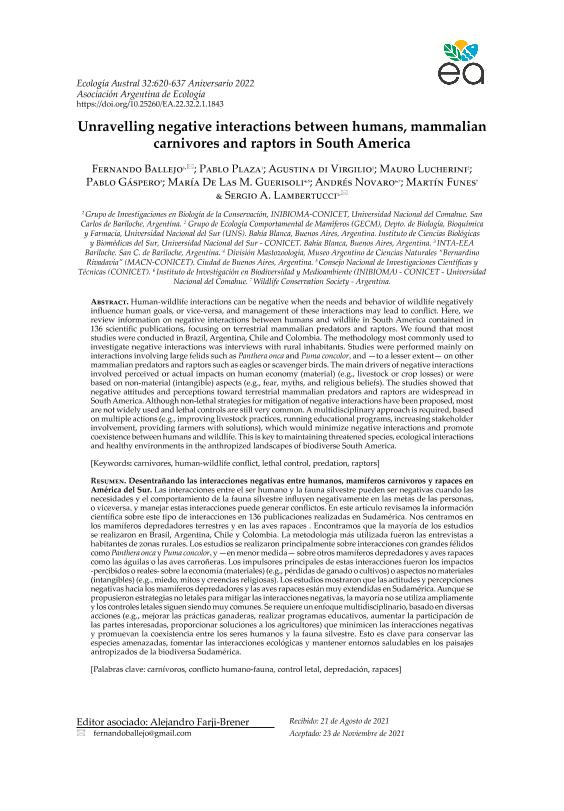Artículo
Human-wildlife interactions can be negative when the needs and behavior of wildlife negatively influence human goals, or vice-versa, and management of these interactions may lead to conflict. Here, we review information on negative interactions between humans and wildlife in South America contained in 136 scientific publications, focusing on terrestrial mammalian predators and raptors. We found that most studies were conducted in Brazil, Argentina, Chile and Colombia. The methodology most commonly used to investigate negative interactions was interviews with rural inhabitants. Studies were performed mainly on interactions involving large felids such as Panthera onca and Puma concolor, and ?to a lesser extent? on other mammalian predators and raptors such as eagles or scavenger birds. The main drivers of negative interactions involved perceived or actual impacts on human economy (material) (e.g., livestock or crop losses) or were based on non-material (intangible) aspects (e.g., fear, myths, and religious beliefs). The studies showed that negative attitudes and perceptions toward terrestrial mammalian predators and raptors are widespread in South America. Although non-lethal strategies for mitigation of negative interactions have been proposed, most are not widely used and lethal controls are still very common. A multidisciplinary approach is required, based on multiple actions (e.g., improving livestock practices, running educational programs, increasing stakeholder involvement, providing farmers with solutions), which would minimize negative interactions and promote coexistence between humans and wildlife. This is key to maintaining threatened species, ecological interactions and healthy environments in the anthropized landscapes of biodiverse South America. Las interacciones entre el ser humano y la fauna silvestre pueden ser negativas cuando las necesidades y el comportamiento de la fauna silvestre influyen negativamente en las metas de las personas, o viceversa, y manejar estas interacciones puede generar conflictos. En este artículo revisamos la información científica sobre este tipo de interacciones en 136 publicaciones realizadas en Sudamérica. Nos centramos en los mamíferos depredadores terrestres y en las aves rapaces . Encontramos que la mayoría de los estudios se realizaron en Brasil, Argentina, Chile y Colombia. La metodología más utilizada fueron las entrevistas a habitantes de zonas rurales. Los estudios se realizaron principalmente sobre interacciones con grandes félidos como Panthera onca y Puma concolor, y —en menor medida— sobre otros mamíferos depredadores y aves rapaces como las águilas o las aves carroñeras. Los impulsores principales de estas interacciones fueron los impactos -percibidos o reales- sobre la economía (materiales) como pérdidas de ganado o cultivos, o aspectos no materiales (intangibles) como miedo, mitos y creencias religiosas. Los estudios mostraron que las actitudes y percepciones negativas hacia los mamíferos depredadores y las aves rapaces están muy extendidas en Sudamérica. Aunque se propusieron estrategias no letales para mitigar las interacciones negativas, la mayoría no se utiliza ampliamente y los controles letales siguen siendo muy comunes. Se requiere un enfoque multidisciplinario, basado en diversas acciones (e.g., mejorar las prácticas ganaderas, realizar programas educativos, aumentar la participación de las partes interesadas, proporcionar soluciones a los agricultores) que minimicen las interacciones negativas y promuevan la coexistencia entre los seres humanos y la fauna silvestre. Esto es clave para conservar las especies amenazadas, fomentar las interacciones ecológicas y mantener entornos saludables en los paisajes antropizados de la biodiversa Sudamérica.
Unravelling negative interactions between humans, mammalian carnivores and raptors in South America
Título:
Desentrañando las interacciones negativas entre humanos, mamíferos carnívoros y rapaces en América del Sur
Ballejo, Fernando ; Plaza, Pablo
; Plaza, Pablo ; Di Virgilio, Agustina Soledad
; Di Virgilio, Agustina Soledad ; Lucherini, Mauro
; Lucherini, Mauro ; Gaspero, Pablo Gabriel; Guerisoli, Maria de Las Mercedes
; Gaspero, Pablo Gabriel; Guerisoli, Maria de Las Mercedes ; Novaro, Andres Jose
; Novaro, Andres Jose ; Funes, Martín; Lambertucci, Sergio Agustin
; Funes, Martín; Lambertucci, Sergio Agustin
 ; Plaza, Pablo
; Plaza, Pablo ; Di Virgilio, Agustina Soledad
; Di Virgilio, Agustina Soledad ; Lucherini, Mauro
; Lucherini, Mauro ; Gaspero, Pablo Gabriel; Guerisoli, Maria de Las Mercedes
; Gaspero, Pablo Gabriel; Guerisoli, Maria de Las Mercedes ; Novaro, Andres Jose
; Novaro, Andres Jose ; Funes, Martín; Lambertucci, Sergio Agustin
; Funes, Martín; Lambertucci, Sergio Agustin
Fecha de publicación:
08/2022
Editorial:
Asociación Argentina de Ecología
Revista:
Ecología Austral
ISSN:
0327-5477
Idioma:
Inglés
Tipo de recurso:
Artículo publicado
Clasificación temática:
Resumen
Palabras clave:
CARNIVORES
,
HUMAN-WILDLIFE CONFLICT
,
LETHAL CONTROL
,
PREDATION
,
RAPTORS
Archivos asociados
Licencia
Identificadores
Colecciones
Articulos(INIBIOMA)
Articulos de INST. DE INVEST.EN BIODIVERSIDAD Y MEDIOAMBIENTE
Articulos de INST. DE INVEST.EN BIODIVERSIDAD Y MEDIOAMBIENTE
Citación
Ballejo, Fernando; Plaza, Pablo; Di Virgilio, Agustina Soledad; Lucherini, Mauro; Gaspero, Pablo Gabriel; et al.; Unravelling negative interactions between humans, mammalian carnivores and raptors in South America; Asociación Argentina de Ecología; Ecología Austral; 32; 2; 8-2022; 620-637
Compartir
Altmétricas



